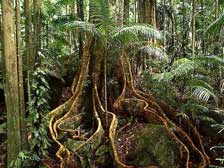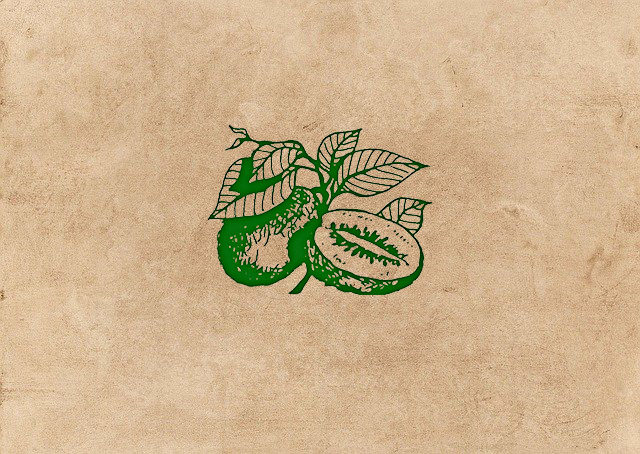How To Plant A Successful Rainforest - 6 Part Series Growing Your
How to plant a successful Rainforest - 6 part series
Growing your future - Natural Forestry
Part one
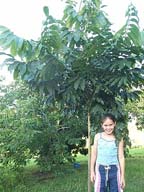 This six part series will assist you, the farmer or landholder to plan, select, plant and maintain a natural forest on your property. The final issue will cover just some of the successful and spectacular projects in our local region.
This six part series will assist you, the farmer or landholder to plan, select, plant and maintain a natural forest on your property. The final issue will cover just some of the successful and spectacular projects in our local region.
If your farm has marginal areas such as those with soil erosion or problem soils, creek banks, laneways, steep areas or gullies these areas can be planted out and stablised with natural forests. There are many success stories of forest projects throughout the northern rivers, a region that offers some of the best Agroforestry and reforestation potential in Australia.
As Emma from Daley's Fruit Tree Nursery explains, "with ¾ of Australian rainforest already cleared in the last 200 years and the areas remaining still at risk of housing development, feral animals and weeds and continued logging there exists a very real need to establish alternative plantations and forest products. Our local growing conditions together with the future demand for high value timber and the spectacular and valuable local species that are available are attracting many landowners towards these type of projects".
Establishing a plot has many advantages other than wood production. Natural forests can substantially increase the value of your property and they offer aesthetic, environmental and social values that are of great importance to our future. They can be integrated into agriculture to benefit farm productivity and sustainability and offer additional benefits such as the sale of timber and associated product; shade and shelter, additional fodder, lowered water tables reducing salinity, reduced wind speed and evaporation, fewer pests by maintaining beneficial predators, provision of habitat, food sources for native fauna or used as buffers between neighbours.
Rainforest plantings offer future delight as the forest grows, the canopy forms and the natural resilience of forest regeneration is displayed.
Planning your Natural Forest
(Part Two)
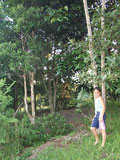 If you're interested in restoring a rainforest, revegetating a creek bank, establishing a wildlife-attracting windbreak, a bushfood jungle or a hardwood Plantation good planning is fundamental. Planning is often an undervalued and frequently overlooked stage of revegetation. As enjoyable as it is to slip a few trees into the ground and cross your fingers, it is just as satisfying and extremely rewarding to watch a 'well-planned' and successful forest system emerge.
If you're interested in restoring a rainforest, revegetating a creek bank, establishing a wildlife-attracting windbreak, a bushfood jungle or a hardwood Plantation good planning is fundamental. Planning is often an undervalued and frequently overlooked stage of revegetation. As enjoyable as it is to slip a few trees into the ground and cross your fingers, it is just as satisfying and extremely rewarding to watch a 'well-planned' and successful forest system emerge.
Northern NSW has the required soils, temperature, rainfall and land availability for successful planting however growing conditions do vary dramatically across the region. The more information you can obtain about your site, the greater the potential for a prosperous forest planting. Information such as soil description, mapping, aerial photographs, seasonal variation, rainfall, site and local species assessment are all well worth the effort.
Fortunately these aspects are easy to uncover and mould to your personally tailored plan in just a few short steps. Consideration towards your species selection, ground preparation, best planting time, maintenance, weed control, nutrition and harvesting regulations are also invaluable. This region is home to some of the best and most innovative small-scale farm forestry programs in Australia as well as an abundance of services, experience and advisory groups in the area; just a few questions in the right direction will quickly become a fascinating exploration.
A good place to start is Daley's Nursery in Geneva. Emma Stone welcomes growers to the nursery and she is happy to share her extensive knowledge and to discuss your plans and approaches.
Some other valuable contacts for further information include:
· The Nth NSW Subtropical Farm Forestry Association
· The Northern Rivers Regional Plantation Committee
· Department of Land and Water Conservation
· Northern Rivers Regional Development Board
· Private advisory groups
· Your local Landcare Group
There is a wide array of experience in our region. In talking to others and exploring case studies be prepared for unexplainable quantities of enthusiasm for this venture.
Down to the Dirt
(Part Three)
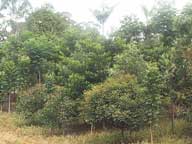 The last article – Planning your Natural Forest - introduced you to all the considerations leading up to the exciting time of getting into the dirt. This month we explore best practice steps for putting you trees into the ground.
The last article – Planning your Natural Forest - introduced you to all the considerations leading up to the exciting time of getting into the dirt. This month we explore best practice steps for putting you trees into the ground.
Planting Time:
In years gone by the Northern Rivers region has offered us a relatively reliable rainfall, this makes for quite a long planting season. The critical component in determining when to plant is weather and this is not quite so predictable. Planting should occur after good rains when the moisture is freely available and the ground is soft making digging easy. This season generally occurs in Feb-March offering the tree time to get its roots established to sustain itself over the winter period.
If planting is small or irrigation is available spring planting is also an option.
Site Preparation:
Deep ripping to 50cm, best done while the soil is dry, increases the water and nutrient availability and encourages fast and deep root development. Planting should occur 15cm to the side of the rip line. Alternatively, when ripping is not achievable, dig the holes 50cm deep and 10-15cm wide, backfill with the same soil after adding fertilizer to the bottom of the hole. When digging your holes be site specific and avoid rocky spots.
Step by Step Planting:
Soak the root ball of the trees one-hour before planting
Dig the hole
Mix fertiliser into the bottom of the hole, ensuring that the fertiliser does not come into direct contact with the roots
Fill the hole with water
Plant the tree to the same level as it is in the pot
Firming the soil around the plant to exclude air pockets
Dish the soil surface for maximum water absorption
Water and mulch
Further watering may be required depending in the season. Heavy mulching will reduce water evaporation particularly over the hot summer season
Fertiliser:
A balanced application of fertiliser into the hole on planting and again about 6 weeks after planting will greatly improve growth. There are many fertiliser options available, speak to your local Rural Supplies store about the most suitable option for your site or enquire with a soil/fertiliser company such as Nutritech Solutions to tailor the fertiliser to your needs.
Weed Control:
Mulching is critical to the speedy development of your new trees, increasing their success by up to 75%. Ideally this is done with weed mats and heavy mulches, which can eliminate weed growth for up to one year and continue to offer moisture retention and provides some nutrient as the mulch breaks down. Weed mats, old sacks, fertiliser bags, hay and mulch can be used. Some weed mats claim to last as long as four years making them available for a second planting season once the trees have growth beyond the potential competition. While mulching increases the cost per tree, it decreases the maintenance and greatly improves the growth rate and success of your planting.
Mulching to a 1m radius around each tree is ideal.
Initial knockdown herbicide can be used however maintenance by continual spraying over and around trees is risky and not usually recommended.
Protection:
Fencing will be necessary when planting in stockyards and individual tree guards may be necessary to protect young trees from rabbits, wallabies and frost.
Placement:
The individual placement of each tree is important especially when planting a mixed rainforest or cabinet timber site. As long-term forester Bruce Chick says “….avoid planting two trees of the same species next to each other, spread them across the planting, they’ll be much happier”. Integrating your fast, medium and slow growing species and your pioneer, secondary and mature species will greatly assist the development, diversity, stability and harvest potential of your forest planting.
Working With Nature -
Selecting Native Species for your Forest Planting
(Part Four)
 Your selection of trees will vary according to your goals and priorities which may range from preserving remnant vegetation, providing wildlife habitat, decreasing fire risk, countering land degradation, proving shelter, improving farm workings (windbreaks, natural pest management), planning a return from timber or increasing the value of the farm by improving aesthetics. Whatever your goal, nature provides us with some basic guidelines for a healthy forest.
Your selection of trees will vary according to your goals and priorities which may range from preserving remnant vegetation, providing wildlife habitat, decreasing fire risk, countering land degradation, proving shelter, improving farm workings (windbreaks, natural pest management), planning a return from timber or increasing the value of the farm by improving aesthetics. Whatever your goal, nature provides us with some basic guidelines for a healthy forest.
The ecosystem of a natural forest involves several layers of plant species. The Northern Rivers is renowned for its richness in biodiversity and it’s worthwhile to plant inline with that which occurs naturally in the locality. By planting pioneer, secondary and mature species the development of a forest can quickly shift into fast-forward.
The initial development and maintenance of a forest planting involves weed control. To limit wee growth it’s advisable to quickly establish a forest canopy. Fast growing pioneers include the Silky Oak (Grevillia robusta), Blue Fig (Elaeocarpus grandis), Red Ash (Alphitonia excelsa), and Satin Tulipwood (Rhodosphaera rhodanthema). Other advantages in establishing a canopy include moisture retention and protection of less hardy species from frost, wind or storm damage.
 Once part shade has been achieved understorey plantings can be introduced and you’ll begin to see the natural appeal of a layered and diverse forest. These plantings can include understorey trees and shrubs, vines, ferns and palms. Keep in mind that the more bird and wildlife attracting species you include the greater the seed dispersal. It’s important to aim for an eventual mixed succession of pioneer, secondary and mature stage species, however in some challenging sites (such as those subject to heavy frosts) you may need to plant hardier pioneers and wait upto1 to 2 years before planting under the protective canopy.
Once part shade has been achieved understorey plantings can be introduced and you’ll begin to see the natural appeal of a layered and diverse forest. These plantings can include understorey trees and shrubs, vines, ferns and palms. Keep in mind that the more bird and wildlife attracting species you include the greater the seed dispersal. It’s important to aim for an eventual mixed succession of pioneer, secondary and mature stage species, however in some challenging sites (such as those subject to heavy frosts) you may need to plant hardier pioneers and wait upto1 to 2 years before planting under the protective canopy.
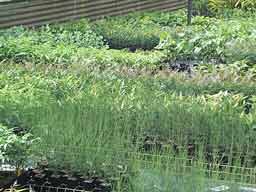 Planting the species you’ve selected is very rewarding so it’s a good idea to contact your local nursery well in advance to pre-order. Emma and the staff at Daley’s Fruit Tree Nursery in Geneva are well equipped and experienced in coordinating plantings. By contacting them in advance they can arrange to propagate local seed or seed collected by yourself in order to ensure the local genetic integrity.
Planting the species you’ve selected is very rewarding so it’s a good idea to contact your local nursery well in advance to pre-order. Emma and the staff at Daley’s Fruit Tree Nursery in Geneva are well equipped and experienced in coordinating plantings. By contacting them in advance they can arrange to propagate local seed or seed collected by yourself in order to ensure the local genetic integrity.
Sharing of local experience is invaluable. For more information or a FREE catalogue visit https://www.daleysfruit.com.au or phone Emma on (02) 66321 441.
Maintenance and Monitoring of your Natural Forest
(Part Five)
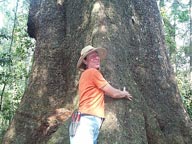 To generate enthusiasm, confidence and a vision of the reality of your endeavour in future plantings, I’d like to offer a picture of the maintenance expectations for establishing trees.
To generate enthusiasm, confidence and a vision of the reality of your endeavour in future plantings, I’d like to offer a picture of the maintenance expectations for establishing trees.
WATER. That’s the topic that is on everybody’s mind at the moment. While water is essential to tree growth it is surprising just resilient they are during dry periods. In well mulched, weed free soil the potential for the soil to retain the adequate moisture levels is quite high. While trees may sit stable through dry periods, the frequency of watering required is obviously dependant on the prevailing weather conditions. If watering is required in the summer, infrequent heavy watering is of greatest benefit as it encourages deep root growth. Shallow frequent watering encourages surface root development and therefore increases their susceptibility to wind throw.
Weed / grass competition is the biggest factor in the short-term success of your forest planting. It is also likely to require the largest portion of time in maintenance. Good weed control in the first two years will certainly pay off, as the quicker the establishment of the canopy the easier the task gets. Weed control with weed mats, or heavy mulch and cardboard, or with herbicide (preferably a non-residual chemical) are among the options however, broad scale herbicide use can be of concern in areas with potential erosion concerns.
Insect and Disease concerns. While planting Australian natives is a relatively safe bet in the field of pest and disease problems, the potential remains. The most likely problems include: Wood borers, caterpillars, scale insects, lerps and sawflies. The best practice for controlling these concerns is regular observation, finding the factor before it reaches the point of concern. If further action is required, consult your tree nursery or another suitable reference.
One aspect of the maintenance program of establishing trees on farms is monitoring. This is a particularly satisfying aspect is frequently overlooked. There is much joy in observing the gradual increase in the diversity of wildlife as trees grow and their food source and habitat expand. This is of course most visible in the diversity of birds. Any tree farmer, with a few years under their belt, will be able to share with you such stories. Another aspect not to be dismissed is the observations of the natural undergrowth appearing. With the increase of birds comes the potential for the natural distribution of understorey species. While this is usually a few years down the track, it is the height of satisfaction as the forest now has momentum of its own.
If your interest in trees on your farm is for timber production in the long term it is advisable to take the time to research your investment thoroughly. While there are many other on-farm values in growing trees, the reality of timber as a commodity is very variable with many influences affecting the long-term market.
Maintenance and monitoring of cabinet timber lots have another ‘branch’ of requirements again. Both pruning, of the lower branches of the trees to encourage vertical growth and a straight tree, and thinning, to allow space for the best specimens, have their specialized techniques and safety requirements. This aspect of maintenance is best performed either with the guidance of, or with contact help from one of the local farm forestry specialists. Speak to Emma at Daleys Nursery or advice can be sought from Sub-Tropical Farm Forestry Association. PO Box 1320 Lismore 2480.
Local Case Studies of Forest Plantings in the Kyogle Area
(Part Six)
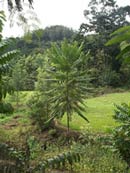 Shane Adams is a highly motivated young man who, given the opportunity to share his story, will surely convince any listener that planting trees is rewarding and fulfilling experience. As a member of the Kyogle shire for just four years, Shane can be held responsible for to the planting of over 4000 trees. He not only has an emerging forest on his small acreage at Black Horse Creek but has also assisted in a number of revegetation projects within the Kyogle town area. He has recently completed an Advanced Diploma in Land Management, as an external student. “Being an external student provided me with the opportunity to base my studies and assessments on many practical case studies in the local area”
Shane Adams is a highly motivated young man who, given the opportunity to share his story, will surely convince any listener that planting trees is rewarding and fulfilling experience. As a member of the Kyogle shire for just four years, Shane can be held responsible for to the planting of over 4000 trees. He not only has an emerging forest on his small acreage at Black Horse Creek but has also assisted in a number of revegetation projects within the Kyogle town area. He has recently completed an Advanced Diploma in Land Management, as an external student. “Being an external student provided me with the opportunity to base my studies and assessments on many practical case studies in the local area”
Previously an engineering student, Shane’s interest in land management began with an increasing attention to the broad environmental issues raised in public awareness campaigns. Shane took the initiative to further investigate the environmental concerns in his local community and after volunteering for a number of land based projects began to develop some strong concerns. Shane’s main focus is the hot topic of water quality and is interested to “bring the public attention to overuse and inappropriate use of Herbicide in Riparian Zones”. This shared concern mobilized the zero-herbicide Land Care Group that has undertaken a number of plantings and management tasks in Kyogle’s ecological pockets.
I had the opportunity to witness Shane’s commitment to revegetation on his property where he has planted over 2500 trees, many of which now tower above his head just three years after planting. Shane started his home-based project with mapping the existing vegetation, waterways, slope and capability of his property. He then went on to form his proposed land use plan. Four years into the project, it is very clear what a mixture of careful thought and well directed energy is capable of producing.
Summarizing his lessons of the last few years, Shane suggests that “biodiversity is not the number of species existing in an area, it is the number of interactions between the species. This complexity provides such a sense of humility in working with ecology”. There is no doubt that the gradual growth and development of Shane’s planting is replicated in his own learning and fulfilment.
Another hard working and motivating person in our local area can more often than not be found at Leeville Public School, working down on the riverbank. He may be by himself, with the children, with volunteers or with other members of Leeville Landcare Group Inc but you can be assured he is always doing something positive for our environment. Meet Ian Gibbs of Mongogarie Rd, Leeville. Ian started his re-vegetation work over 10 years ago, on his own property, where he has planted over 200 trees as windbreaks and habitat trees for the local birds and animals, which he says he can see increasing in numbers every year. Ian mentions other benefits of his plantings are the cooling effects the trees have on his property, and the decrease in wind speed. Ian’s motivation behind all his work is his awareness of the impact of land clearing in the local area and is concerned about habitat areas for our native fauna species.
Ian has been a ringleader of the Leeville Landcare Group for many years. He has helped organise, plan and implement many projects in the area, including a 2 ½ Ha forest planting. Currently Ian’s main interest is in educating the younger generations about the benefits of trees, their important role in our ecosystems and the benefits of a healthy riparian zone. He has educated the children in seed collecting from local trees, propagating these seeds at the school and then planting these seedlings back on the riverbanks where they originated. Through this they can see the whole natural process of re-vegetation and learn about many of the local native and weed species.
The main issues Ian points out for the local area are WATER QUALITY and WEEDS. He believes weeds are the biggest problem we have to deal with as well as keeping stock out of our watercourses. Once you have done this, “the regeneration process does it itself, especially if you have a good seed source nearby”. Ian has recently finished his Bushland Regeneration Certificate and is always actively learning more.
These two people are an example of some of the experience and enthusiasm alive in the Kyogle Shire.
